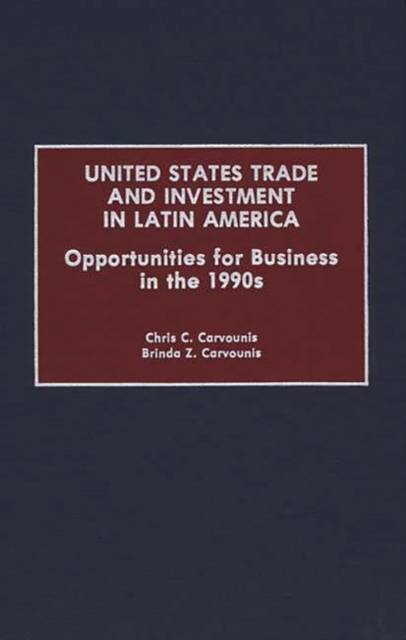
- Afhalen na 1 uur in een winkel met voorraad
- Gratis thuislevering in België vanaf € 30
- Ruim aanbod met 7 miljoen producten
- Afhalen na 1 uur in een winkel met voorraad
- Gratis thuislevering in België vanaf € 30
- Ruim aanbod met 7 miljoen producten
United States Trade and Investment in Latin America
Opportunities for Business in the 1990s
Chris C Carvounis, Ronald SimsOmschrijving
This timely book examines the quiet revolution that is currently unfolding in Latin America and its likely consequences for U.S. trade and investment with and within that region. Receiving meager coverage by America's media, a virtual sea of change has taken place in Latin America during the past few years. Democratically elected leaders have labored to extricate their economies from the debt-laden stagnation of the lost decade by pursuing far-reaching stabilization and liberalization reform programs. Under President George Bush's proposed Enterprise Initiative for the Americas (EAI) and negotiations toward the formation of a North American Free Trade Area (NAFTA) with Mexico, U.S. economic policy toward Latin America is now in the midst of a dramatic revision that seeks to rectify the neglect of the past and replace it with active encouragement of economic and political change. The authors investigate the forces behind the lost decade in Latin America, the adjustment efforts that have emerged in its wake, and the enhanced potential of Latin economies as trade partners and investment outlets under the EAI and NAFTA. They look at these developments in the light of regionalizing trends afoot in the global economy at large and argue that stronger ties with Latin America are essential to the future well-being of the United States.
After outlining the emergence of global economic regionalism and its likely impact upon the United States and Latin America, the authors trace the origins of the latter's lost decade to the debt crisis of the early 1980s, the inadequacy of past international strategies to manage it, and the adoption of strenuous adjustment programs by Latin nations to deal with both debt repayment and the legacy of misguided development approaches. They show how the EAI is meant to accelerate the movement toward reliance upon free-market forces in Latin America and how the United States is likely to benefit from closer economic ties with the countries of that region. A full account of NAFTA's proposed liberalization of trade between the United States and Mexico follows, as the authors investigate its origins, examine Mexico's adjustment record, and list the gains that both nations are likely to realize under a free-trade accord. They then look at two sets of Latin economies, the first of which is formed by Chile, Venezuela, Bolivia, and Colombia and the second comprised of Brazil, Argentina, and Peru. While the former are prepared for economic integration with the United States, major problems impair the ability of the latter to become full-fledged participants in an economic pact with the United States. The analysis presented in the book should be of substantial value to businessmen, students of world affairs, as well as those with a specific interest in U.S.-Latin relations.Specificaties
Betrokkenen
- Auteur(s):
- Uitgeverij:
Inhoud
- Aantal bladzijden:
- 256
- Taal:
- Engels
- Reeks:
Eigenschappen
- Productcode (EAN):
- 9780899307862
- Verschijningsdatum:
- 20/10/1992
- Uitvoering:
- Hardcover
- Formaat:
- Genaaid
- Afmetingen:
- 161 mm x 241 mm
- Gewicht:
- 517 g

Alleen bij Standaard Boekhandel
Beoordelingen
We publiceren alleen reviews die voldoen aan de voorwaarden voor reviews. Bekijk onze voorwaarden voor reviews.









